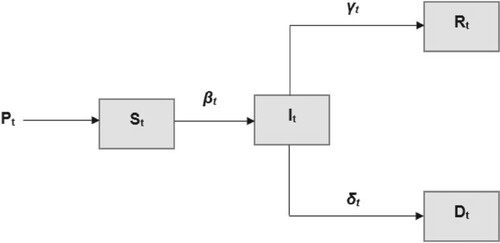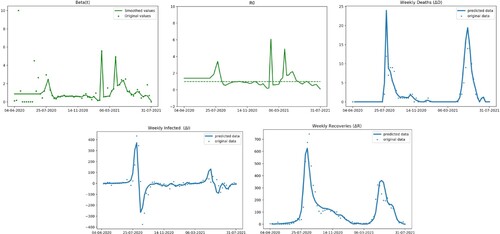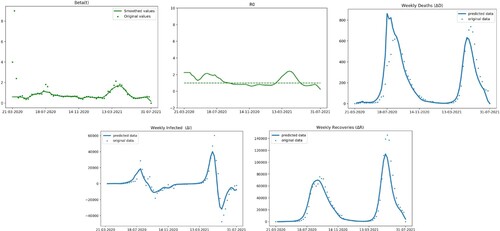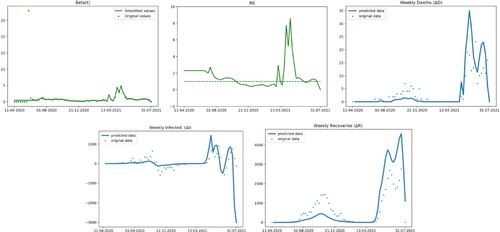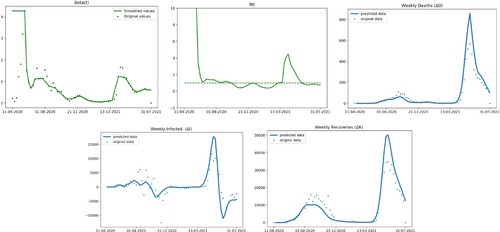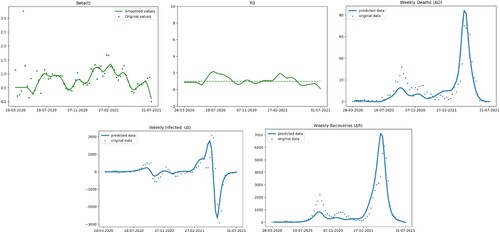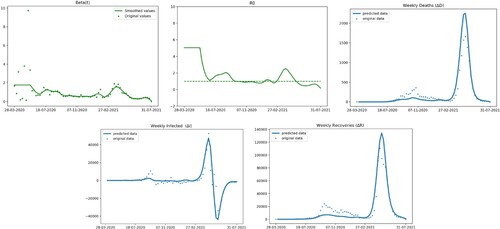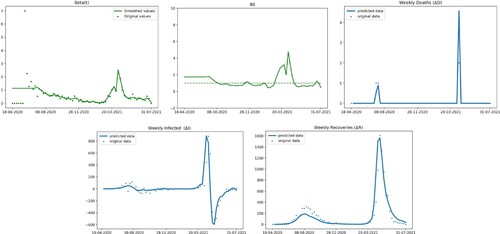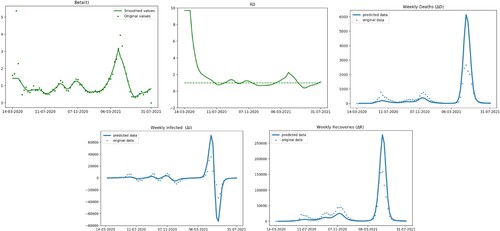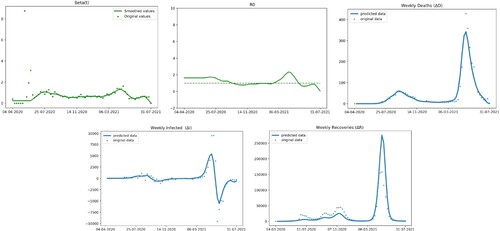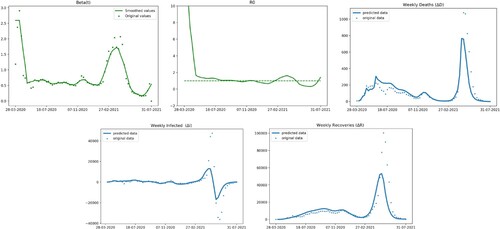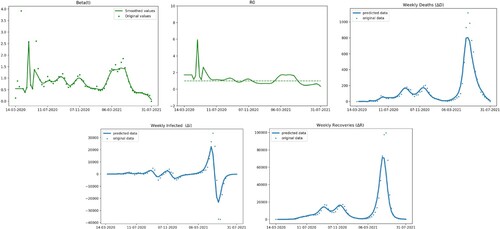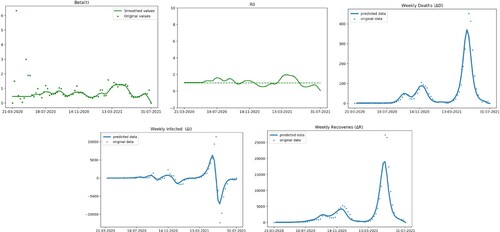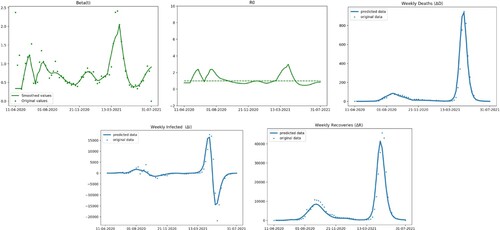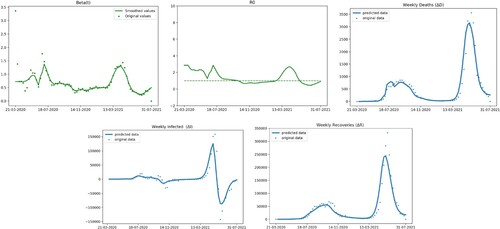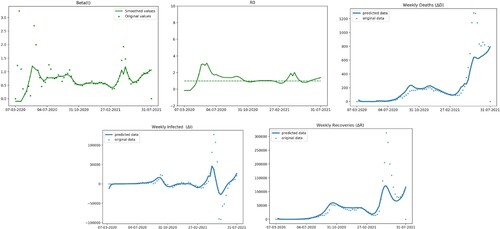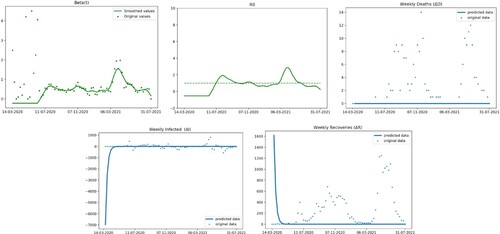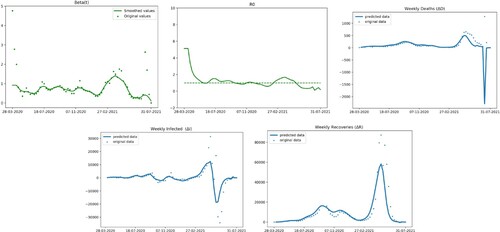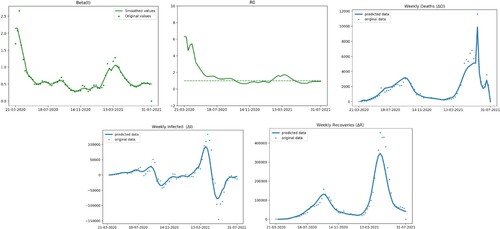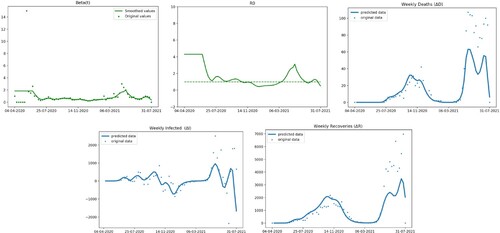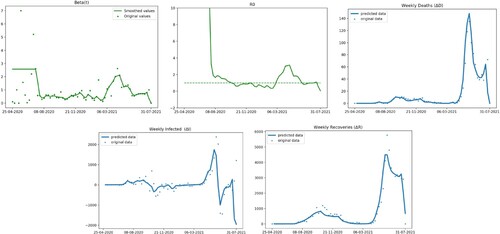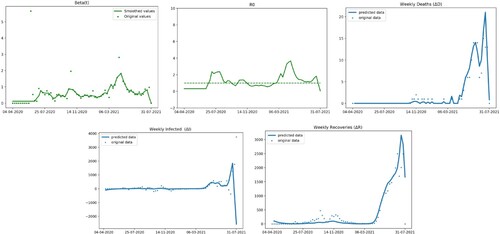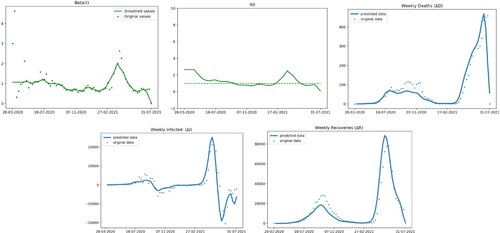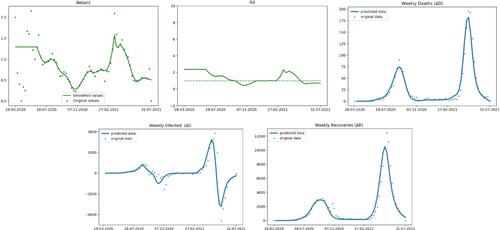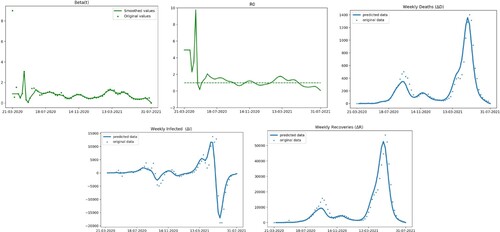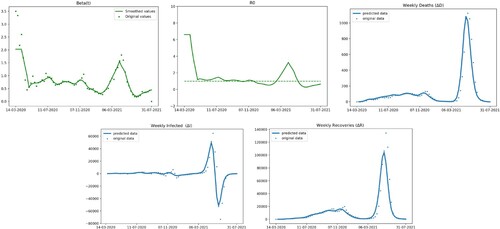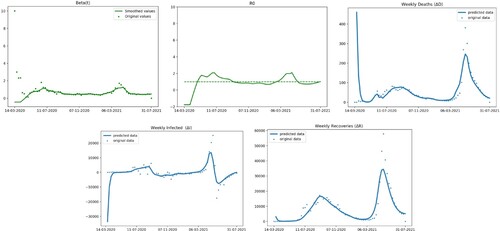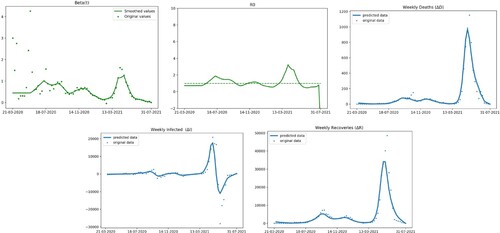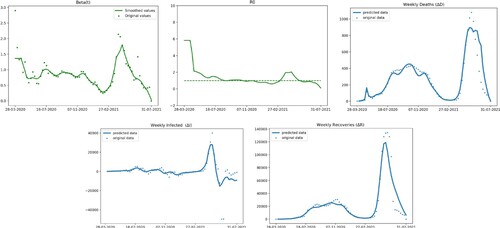 ?Mathematical formulae have been encoded as MathML and are displayed in this HTML version using MathJax in order to improve their display. Uncheck the box to turn MathJax off. This feature requires Javascript. Click on a formula to zoom.
?Mathematical formulae have been encoded as MathML and are displayed in this HTML version using MathJax in order to improve their display. Uncheck the box to turn MathJax off. This feature requires Javascript. Click on a formula to zoom.Abstract
In this paper, the existing Susceptible-Infected-Recovered-Deceased (SIRD) compartmental epidemiologic process model is modified for forecasting the coronavirus effect in India. The data from India was studied for weekly fatalities, weekly infected, weekly recovered, new cases, infected and recovered individuals, Reproductive Number , recovery rate, death rate, and coefficient of transmission from 30 January 2020 to 31 July 2021. SARS Coronavirus 2 (SARS-CoV-2) is the Covid strain that causes Covid sickness (COVID-19), a respiratory ailment that triggered the outbreak of COVID-19 at the beginning of December 2019. We aim to provide a hybrid SIRD model for predicting the COVID-19 outbreak. In the proposed method, to improve the exploration ability of the Grey Wolf Optimizer (GWO) or to avoid stagnation in the swarm, a modified Grey Wolf Optimization Algorithm is used to optimize the initial value of Infected individuals. The modified SIRD model is further applied to get the predicted values. The data is examined on weekly basis to prevent noise. Depending on the fact, that the precise mode of transmission is highly dependent on how and when different precautions such as isolation, confinement, and other preventative measures were implemented, we put together our projections concerning satisfactory speculations based on genuine realities. The experimental results show the various trends observed in the pandemic in terms of number of peaks, increasing trend, decreasing trend, and continuous trend for infected individuals, weekly change in number of cases, weekly deaths, weekly infected, and weekly recoeverd cases of Covid-19. The proposed modified SIRD model could be a valuable tool for assessing the impact of government measures on COVID-19 outbreak.
1. Introduction
An infectious disease caused by the virus SARS-CoV-2 is known as COVID-19 or Coronavirus disease. Depending upon the symptoms, a person infected with this virus may experience benign or severe respiratory ailment. COVID-19 is likely to cause extreme conditions in older people with previous medical history such as diabetes, cancer, or cardiovascular disease [Citation1]. The COVID-19 virus can be best envisioned with the help of the SIRD compartmental model [Citation2].
The Susceptible-Infected-Recovered-Deceased (SIRD) is a compartmental epidemiological procedure model [Citation3] used to study epidemics. This model has been incorporated to analyse the data in this paper. One of the most general mathematical modelling techniques for infectious diseases is the Compartmental model. The compartments have the labels such as ,
, or
, which are assigned the population. There may be chances of progress amidst compartments. The flow patterns among the different compartments can be visualized with the help of the order of the labels given [Citation4]. For example, susceptible, exposed, infectious, then susceptible again, follow the pattern SEIS [Citation5].
Many researchers have used the SIRD model for analysing the situation of COVID-19 worldwide. Coccavo [Citation6] used the SIRD model to predict the impact of COVID-19 in China and Italy. Calafiore et al. [Citation7] used a time-varying SIRD model for predicting the COVID-19 contagion in Italy by using the official data to identify the model parameters. Sen and Sen [Citation8] used the modified SIRD model to analyse the time-series data of COVID-19 for China, Italy, France, the United States, and India. Khajanchi et al. [Citation9] performed a sensitivity analysis using partial rank correlation coefficients approaches to determine the most effective parameters. By using the least squares method, the value of those sensitive parameters was calculated from the observed data. To find out how important the system parameters are in relation to one another, they conducted sensitivity analysis. To assess how resistant the model predictions are to parameter values, they also computed the sensitivity indices.
To evaluate the effectiveness of social media advertising in containing the coronavirus pandemic in India, Rai et al. [Citation10] provided a mathematical model. They calibrated the suggested model using India's total number of confirmed COVID-19 cases. Eight epidemiologically significant factors were estimated, along with the size of India's basic reproduction number, in their study. Samui et al. [Citation11] proposed a SAIU compartmental mathematical model to account for the COVID-19 transmission dynamics. They analysed local and global stability for the endemic and infection-free equilibrium point. Also, to determine the factors that are most useful in relation to the fundamental reproduction number R0, a sensitivity analysis is carried out. Khajanchi and Sarkar [Citation12] created a brand-new compartmental model that clarifies the COVID-19 transmission kinetics. With daily COVID-19 data for four Indian states–Jharkhand, Gujarat, Andhra Pradesh, and Chandigarh–they calibrated their model. They examined the model's qualitative characteristics, including the model's possible equilibria and their stability with regard to the fundamental reproduction number R0.
Sarkar et al. [Citation13] proposed a SARIIqSq compartmental mathematical model to account for the COVID-19 transmission dynamics. They determined the most sensitive parameters by doing a PRCC analysis, based on actual data up to 30 April 2020. To determine the most efficient parameters in relation to the fundamental reproduction number R0, a sensitivity analysis was carried out in their work. Khajanchi et al. [Citation14] used the susceptible-exposed-infectious-recovered model, which was improved using contact tracing and hospitalisation data from the Indian provinces of Kerala, Delhi, Maharashtra, and West Bengal, as well as from India as a whole. They determined The most important input parameters through sensitivity analysis, and the model has been calibrated to provide the most accurate description of the data. Long-term projections also indicate the probability of oscillatory dynamics, while short-term predictions indicate an increasing and concerning trend in COVID-19 instances for all four provinces and India as a whole.
Ghosh et al. [Citation15] applied the regression methods for capturing the competing risks to COVID-19. The cause-specific and sub-distribution risks regression techniques, which are applied to the COVID-19 incidence data from the USA, are the methods that are most frequently utilized in their work. Ghosh et al. [Citation16], in order to demonstrate relative risks and cumulative mortality rates using COVID-19 data from Spain, they first devised a non-parametric technique for odds ratios with appropriate confidence intervals (CIs). Using the Italian COVID-19 data, they have shown how the modified non-parametric approach based on the Kaplan-Meier (KM) algorithm works. Additionally, they looked at the importance of patient characteristics in relation to outcome by age for both genders. Saha et al. [Citation17] employed control measures to lessen the illness burden, for which, an optimal control problem is taken into account. Numbers demonstrate that the behavioural response control first operates with greater intensity after deployment before gradually waning over time.
Susceptible (S), asymptomatic infected (A), clinically ill or symptomatic infected (I), quarantine (Q), isolation (J), and recovered (R) are the six stages of infection that were taken into consideration by Mondal and Khajanchi [Citation18]. These six stages are generally referred to as SAIQJR. In terms of the fundamental reproduction number, the qualitative behaviour of the model and the stability of biologically plausible equilibrium points are examined. With regard to the fundamental reproduction number, they conducted sensitivity analysis and discovered that the illness transmission rate has an effect on preventing the spread of diseases. Tiwari et al. [Citation19] derived the expression for fundamental reproduction number. They established the necessary criteria for endemic equilibrium to be stable globally. To determine the essential model parameters that have a significant impact on the prevalence and management of COVID-19, sensitivity analysis was performed. They modified the suggested model to meet the COVID-19 case data set for India. They provided the simulation results which demonstrate that spreading awareness among vulnerable people at the community and individual levels is essential for preventing the COVID-19 disease.
In the scenario of COVID-19, once infected, a person either heals or dies. Our approach, unlike the traditional version, is based on the following presumptions:
Every individual transition between the compartments is dynamic and therefore dependent on time.
Time-dependency is directly impacted by the frequency of non-pharmaceutical inferences. As a result, estimating a comparable reduction in the disease's transmission rate may be useful in assessing how well these conclusions performed.
This work is an extension of our previous work on Covid-19 [Citation20], where we intend to analyse the weekly data as our future scope. The proposed model is used to examine the evolution of COVID-19 [Citation21]. This methodology has been adopted by 35 Indian States and Union-Territories (UTs). Susceptible (S), Infected (I), Recovered (R), and Dead (D) are the four stages of infection that the model goes through.
To identify the initial value of Infected individuals, we have used Grey Wolf Optimization (GWO) algorithm. GWO [Citation22] is a recent nature-inspired algorithm that imitates the behaviour of grey wolves. It consists of the alpha (α), beta (β), omega (ω), and delta (δ), forming the four main classes of the GWO. GWO works on four phases: encircling the prey, hunting the prey, attacking the prey (exploitation), and searching for prey (exploration).
The paper is structured as follows: Model structure and method are described in Section 2. Results analysis is covered in Section 3. The conclusion is presented in Section 4.
2. Model structure and method
The total population P [Citation23] at time t comprises of the total number of ,
,
, and
individuals.
2.1. The SIRD model
Equation (Equation1(1)
(1) ) computes the value of total population
:
(1)
(1) Equation (Equation2
(2)
(2) ) computes the change in the cases reported:
(2)
(2) An approximately constant value is estimated by Equation (Equation1
(1)
(1) ). The value of
,
,
, and
is computed using the following equations:
(3)
(3)
(4)
(4)
(5)
(5)
(6)
(6) At the beginning, the total susceptibles
individuals were approximately equivalent to the total polulation
. Equations (Equation7
(7)
(7) ) and (Equation8
(8)
(8) ) computes the per week exponential growth rate
and the underlying dimensionless Reproductive Number
[Citation24]:
(7)
(7)
(8)
(8) If the value of
, the COVID-19 pandemic progresses, or else crumbles.
2.2. Effects of government interventions 25–32 on COVID-19 outbreak
Suppose that the weekly change in susceptible individuals is computed as . where,
stands for average number of susceptible at
week (average of 7 days data ending at the end of week t (included))
stands for average number of susceptible at
week (average of 7 days data, counting from next day from the end of week t),
Here
= 0
Equations (Equation9(9)
(9) )–(Equation12
(12)
(12) ) computes the weekly change of Infected, Recovered, and Deceased individuals:
(9)
(9)
(10)
(10)
(11)
(11)
(12)
(12) The above equations are used to determine the transmission coefficient, recovery rate, and death rate.
The change in the number of total cases (Equation2(2)
(2) ) was very less in comparison to the total population
. This leads to making the total population nearly equal to susceptible individuals and hence
. In the case of large data, such as used in our work from 30 January 2020 to 31 July 2021, a modified SIRD model is requisite, to calculate the near accurate values as
is large. In the modified SIRD model the equation of transmission coefficient is modified and computed as: From Equation (Equation9
(9)
(9) ),
(13)
(13) From Equations (Equation2
(2)
(2) ), (Equation11
(11)
(11) ) and (Equation12
(12)
(12) ),
(14)
(14) From Equation (Equation1
(1)
(1) ),
(15)
(15)
(16)
(16)
(17)
(17)
(18)
(18) The value of the transmission coefficient will be less when the total population is equal to susceptible individuals
, resulting in low
values as compared to the beta values procured by taking
, which results in higher
values. This concludes to imprecise predictions when
, exclusively when
is relatively 1.
The values of ,
,
,
, and
can be used to compute the SIRD parameters.
The COVID-19 pandemic can be analysed using the parameters specified in Table .
Table 1. The SIRD model parameters.
The tremendous amount of noise, in terms of process and measurement, can be seen in the values of the parameters due to the following reasons: The infected individuals were relatively less at the beginning of the pandemic, resulting in high process noise. The disruption in reporting of daily cases and the misclassification and misunderstanding of COVID-19 cases by the government authorities may result in higher measurement noise. The process of data smoothing may help to reduce the process and measurement noise.
2.3. Model requirements
2.3.1. Description of dataset
The dataset from 30 January 2020 to 31 July 2021, is collected from COVID19 INDIA [Citation33]. The data collected is unforeseen eminently, as a result of reliance on physical variables for increase or decrease in total cases. The dataset contains 35 absolute time-series data for the number of confirmed, recovered, and deceased cases recorded in each of India's states and union territories. Table consists of the dataset values, where 1L = and, 1Cr =
.
Table 2. Dataset (30 January 2020 to 31 July 2021).
2.3.2. Methodology
The computed time-series of weekly data can be used to further evaluate the time-series data of the following:
The number of New Cases
(19)
(19)
The number of Infecetd/Active Cases
(20)
(20)
The number of Weekly Deaths
(21)
(21)
SIRD parameters weekly estimates can be computed by using the above equations.
In our approach, we have used Locally Weighted Scatterplot Smoothing (LOWESS) [Citation34], for smoothing of data. LOWESS is a famous tool that draws a smooth line over a timeplot/scatterplot witnessing the relationship among the variables and predictive trends. It is used in Regression Analysis. In order to move closer to the straight line rather than curves, a fraction of 0.1 is estimated for and δ and a fraction of 0.2 is estimated for γ.
Since for small values, the data is excessively noisy, the smoothing of parameters is only applied as soon as surpasses 100 cases. A constant value is assigned to
until it attains 100 cases and is assigned a value equivalent to the first value smoothed.
The modified SIRD model is calculated ahead of time for time period of the pandemic, by smoothing the model parameters. Suppose the initial values of the SIRD model as S(0)= N, R(0)=D(0)=0, and the optimal value of I(0) is obtained using the Modified Grey Wolf Optimizer (GWO) Algorithm.
3. Formulation of optimization problem for initial value of infected individuals (
 )
)
The initial value of Infected individuals can be obtained in different ways with the help of the data. Finding the most suitable value of
is very challenging. We have used the optimization method to obtain the initial I. The Modified GWO is used to identify the optimal initial value of the infected individuals (
), so that the mathematically generated data is near the real reported data.
3.1. Grey wolf optimizer (GWO)
The GWO algorithm developed by Mirjalili [Citation22] is a population-based metaheuristic algorithm, designed to explore and construct a heuristic (partial search algorithm), to find an optimal solution for any optimization problem. All the algorithms with randomization and local search capacity are known as metaheuristic algorithm [Citation35]. Metaheuristic algorithms can relatively handle problems with a huge population [Citation36]. Unlike other optimization algorithms, metaheuristic algorithms do not assure to obtain the optimal solution, but they are capable of computing sub-optimal, good-quality solutions and take feasible execution time [Citation37]. GWO is one such type of metaheuristic algorithm that mimes the attacking behaviour and management hierarchy of grey wolves. In GWO, to fabricate the management hierarchy, the colony of wolves is divided into primarily four main classes, alpha (α), beta (β), omega (ω) and delta (δ). The alpha wolf is the leader and considered the best ones. They are responsible for making decisions for hunting, time to sleep, waking up time and so on. Beta is the second-level wolves. They are the auxiliary wolves that help alpha wolves in decision-making and other activities. Delta is the third-best, and it is responsible for sacrifice. These wolves are responsible for dominating other wolves. Omega is the lowest-ranked grey wolves. They are considered as the weaklings and are ready to sacrifice. All other wolves are delta wolves.
The working of GWO can be described in the following four steps:
Encircling prey
Hunting
Attacking prey (Exploitation)
Search prey (Exploration)
The mathematical model for hunting the prey, attacking on the prey, and to search the prey is described in this section.
3.1.1. Encircling prey
The encircling of prey by the grey wolves is given mathematically by the following equations: (22)
(22)
(23)
(23)
(24)
(24)
(25)
(25)
(26)
(26) where t denotes the current iteration, vector A and C indicates coefficient vectors.
and G indicates the position of prey and grey wolf respectively. a is a vector which linearly decreases from 2 to 0 over the course of iterations.
and
are random vectors in the range [0,1]. Initially, vector A has a maximum value, which decreases gradually as the iterations increase which can be calculated by Equation (Equation6
(6)
(6) ). I indicates the maximum number of iterations.
3.1.2. Hunting
To mathematically simulate the hunting behaviour of grey wolves, the α, β, and δ are considered as the best solution which possesses better information about the location of prey (optimal). Based on this information, other grey wolves update their positions using the following equations [Citation22] : (27)
(27)
(28)
(28)
(29)
(29) where,
(30)
(30)
3.1.3. Attack on prey (Exploitation) and search prey (Exploration)
The exploitation and exploration behaviour in the GWO algorithm, depends upon the A and C parameters. A is a random value in the range [-a,a]. The wolf shows exploration behaviour when >1 and C >1, whereas exploitation occurs when
<1 and C <1.
To improve the exploration ability of the GWO or to avoid stagnation in the swarm, a modified solution search strategy is proposed in this section. As the whole swarm is attracted towards the best prey , so on the basis of
location, there may be a situation that the swarm may converge to local optima or may stuck at some other location in the search space. To avoid this situation, a fluctuation is introduced in the swarm i.e. the
solution is randomly generated in the swarm, if it is not updating itself up to a predefined number of iterations named as ‘alphathreshold’ and in next-generation, the first, second, and third best solutions are selected as
,
, and
respectively. Hence, it is expected that the exploration ability of the GWO will be improved, and the same is proved through experiments.
The following values of Modified GWO are taken into consideration for calculations:
| – | Objective Function: | ||||
| – | Lower and Upper Bound: 0 and 200,000 respectively | ||||
| – | Dimensions: One-Dimensional | ||||
| – | Number of Search Agents: 16 | ||||
| – | Maximum Iterations (T): 100 | ||||
Algorithm 1 describes the pseudo-code of the Modified GWO algorithm:
The steps of the algorithm are illustrated below:
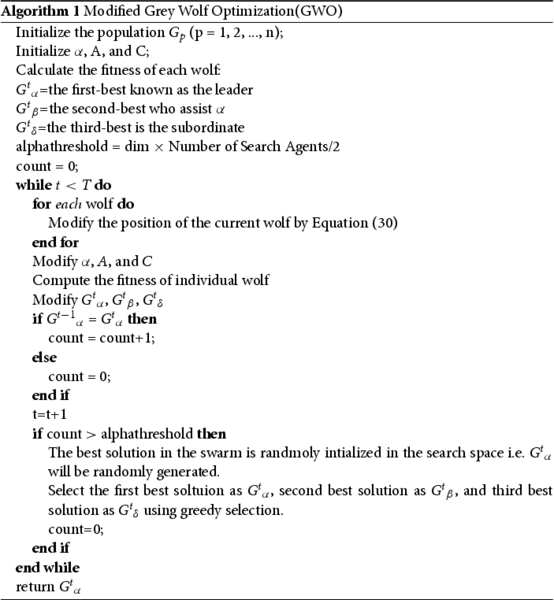
To measure how fit is our model, we have estimated the coefficient of prediction by Equation (Equation31
(31)
(31) )
(31)
(31) where:
The data is given by X and the number of confirmed and recovered cases for model prediction is given by Y.
If the model predictions are worst in comparison to the data mean, the value of may be negative. The prediction is near to accurate if
reaches 1.
The value of , before and after smoothing of model parameters is given in Table . On the basis of obtained values after smoothing of model parameters, we can observe that the proposed model fits best on the given data. The model does not fit on Ladakh due to the inconsistency in data.
Table 3. Comaprative analysis of for all States/UT of India.
4. Experimental results
On 30 January 2020, the first case in India of Covid-19 was reported to WHO [Citation38]. This section illustrates the detailed analysis of peaks and recent trends of Infected individuals, weekly change in number of cases, weekly deaths, weekly infected and weekly recoeverd cases of Covid-19, in tabular and graphical form.
4.1. Analysis of peaks and recent trends
The Table below illustrates the Peaks and Recent Trends of Infected individuals, weekly change in number of cases, weekly deaths, weekly infected and weekly recoeverd cases of Covid-19 in India from the beginning to July 31, 2021. Here,
| – | Numbers (1,2,3): Specifies the number of peaks | ||||
| – | Upward Arrow (↑): Specifies increasing trend | ||||
| – | Downward Arrow (↓): Specifies decreasing trend | ||||
| – | Right Arrow ( | ||||
| – | AD: Abruptly Down last value | ||||
| – | NM: Not Matching; data and continuous curve | ||||
Table 4. Peaks and recent trends.
From Table , we can observe the following recent (end of July 2021 to beginning of August 2021) trends:
Infected (I): A downward (↓) trend can be observed for the majority of States/UT, except for Arunachal Pradesh, Kerala, Manipur, Meghalaya, Mizoram, Nagaland, and Sikkim which shows an increase in infection (↑). Assam shows a stationary or constant trend (
).
Number of New Cases (
): A downward (↓) trend in the number of new cases can be observed for all the States/UT.
Number of Weekly Deaths (
): A downward (↓) trend can be observed for the majority of States/UT, except for Arunachal Pradesh. Dadra and Nagar Haveli & Daman and Diu shows a stationary or constant trend (
) of deaths.
Number of Weekly Infected (
): An upward (↑) trend can be observed for the majority of States/UT, except for Arunachal Pradesh, Mizoram, Nagaland, Tripura, and Meghalaya, which shows a relatively less number of weekly infected cases, resulting in a downward trend (↓). Assam and Delhi show a stationary or constant trend (
) of weekly infected.
Number of Weekly Recovered (
): A downward (↓) trend can be observed for the majority of States/UT. Delhi shows a stationary or constant trend (
) of weekly recovered.
Transmission Coefficient (
): Shows a downward (↓) trend for all the States/UT.
Confirmed (C): Shows an upward (↑) trend for all the States/UT.
Deceased (D): Shows an upward (↑) trend for all the States/UT.
Death Rate (δ): Shows a downward (↓) trend for all the States/UT, except for Dadra and Nagar Haveli & Daman and Diu, which shows a stationary or constant trend (
) in the death rate.
Recovery Rate (γ): Shows a downward (↓) trend for all the States/UT.
Reproductive Number (
): A downward (↓) trend can be observed in the majority of States/UT, except for Gujarat, Jharkhand, Karnataka, Kerala, Rajasthan, and Telangana, which shows upward (↑) trend. Delhi shows a stationary or constant trend (
).
Exponential Growth Rate (
): A downward (↓) trend can be observed in per week growth rate of the pandemic in the majority of States/UT, except for Gujarat, Kerala, Maharashtra, Rajasthan, Telangana, and Uttarakhand, which show upward (↑) trend. Delhi, Haryana and Madhya Pradesh shows a stationary or constant trend (
).
Recovered (R): Shows an upward (↑) trend for all the States/UT.
4.2. Analyzing the effects of lockdowns, unlock, and vaccinations using reproduction number 

The Government details are given as follows: Lockdowns (25-03-2020 to 31-05-2020), Unlock (01-06-2020 to 31-03-2022) and vaccinations ( years from 01-03-2021;
years from 01-04-2021 and
years from 01-05-2021. The effects of Government's measures were felt by the public [Citation39] and are detailed in Table using
for each State. In analysing the data, a very few data points were not taken into account considering them as ‘outliers’. The effects measured by
were noticed some time after the Government measures were announced.
Table 5. Effects of government measures using .
We may observe the data provided in Table as one and a half (maximum) waves data. The > = two (maximum) waves data are observed in the following states:
2 (maximum) waves data:
– Chandigarh: 28-02-2020 (0.55 to 0.89) 06-06-2020 (1.20 to 2.17) 12-09-2020 (0.61 to 0.97) 26-12-2020 (1.02 to 1.91) 01-05-2021 (0.10 to 0.93) 31-07-2021.
– Delhi: 14-03-2020 (1.19 to 9.69) 27-06-2020 (0.75 to 1.38) 14-11-2020 (0.65 to 0.97) 13-02-2021 (1.02 to 2.25) 08-05-2021 (0.39 to 1.00) 31-07-2021.
– Ladakh: 14-03-2020 (-0.18 to 0.68) 04-07-2020 (1.00 to 1.92) 21-11-2020 (0.58 to 0.98) 27-02-2021 (1.08 to 2.85) 15-05-2021 (0.22 to 0.97) 31-07-2021.
– Mizoram: 04-04-2020 (0.31 to 0.84) 27-06-2020 (1.04 to 2.35) 07-11-2020 (0.54 to 0.95) 20-02-2021 (1.02 to 3.64) 31-07-2021.
– Telangana: 14-03-2020 (-1.80 to 0.40) 02-05-2020 (1.11 to 2.08) 05-09-2020 (0.67 to 0.98) 13-02-2021 (1.01 to 2.07) 01-05-2021 (0.70 to 0.99) 31-07-2021.
– Tripura: 18-04-2020 (0.14 to 0.90) 27-06-2020 (1.25 to 1.76) 12-09-2020 (0.39 to 0.98) 27-02-2021 (1.18 to 3.40) 29-05-2021 (0.15 to 0.96) 31-07-2021.
3 (maximum) waves data:
– Uttarakhand: 21-03-2020 (0.73 to 0.95) 06-06-2020 (1.11 to 1.87) 19-09-2020 (0.70 to 0.99) 07-11-2020 (1.07 to 1.16) 12-12-2020 (0.53 to 0.98) 27-02-2021 (1.12 to 3.19) 08-05-2021 (0.45 to 0.98) 31-07-2021
3
(maximum) waves data:
– Kerala: 07-03-2020 (-0.15 to 0.57) 18-04-2020 (1.05 to 3.13) 17-10-2020 (0.88 to 0.99) 05-12-2020 (1.01 to 1.04) 30-01-2021 (0.72 to 0.96) 20-03-2021 (1.00 to 2.01) 15-05-2021 (0.81 to 0.97) 19-06-2021 (1.07 to 1.39) 31-07-2021
4.3. Graphical analysis of βstates/UT of India
In our work, instead of providing graphs for 13 parameters, we have selected 5 important parameters (,
,
,
, and
) to reduce the size of the article. The Figures – demonstrates the graphical analysis of
,
,
,
, and
for all States/UT of India.
From the graphs we observe that:
Andaman and Nicobar Islands: In Andaman & Nicobar Islands, over time, the transmission coefficient decreased, signalling a decline in COVID-19 cases. This decrease in transmission was reflected in a drop in the reproductive number and a reduction in weekly deaths. However, despite this decline, the number of new infections remained high, leading to a lower recovery rate among individuals infected on a weekly basis.
Andhra Pradesh: In Andhra Pradesh, there has been a gradual reduction in the transmission coefficient, indicating a decline in COVID-19 cases. This decrease in transmission has corresponded to a decrease in the reproductive number and a reduction in weekly fatalities. Nevertheless, despite this decline, the volume of new infections has persisted at a high level, resulting in a lower recovery rate for individuals contracting the virus on a weekly basis.
Arunachal Pradesh: In Arunachal Pradesh, as time progressed, the transmission coefficient decreased, leading to a decline in the reproductive number. Although the number of weekly deaths remained constant, there was a decrease in the weekly infected individuals and weekly recoveries.
Assam: In Assam, with time, the decreasing transmission coefficient resulted in a decline in the reproductive number. Despite a rise in weekly deaths, there was no alteration in the number of weekly infected individuals, while weekly recoveries experienced a decrease.
Bihar, Chandigarh, and Chhatisgarh: In Bihar, Chandigarh, and Chattisgarh, a decrease in the transmission coefficient led to a lower reproductive number, indicating a decrease in COVID-19 cases. However, there was an observed increase in weekly deaths, a rise in the number of weekly infected individuals, and a decrease in weekly recoveries.
Dadra & Nagar Haveli and Daman & Diu: In Dadra & Nagar Haveli and Daman & Diu, the drop in the transmission coefficient caused a decrease in the reproductive number. Weekly deaths stayed steady while the number of infected individuals increased, and weekly recoveries declined.
Delhi: In Delhi, there was a decrease in the transmission coefficient, while the reproductive number remained steady over time. Weekly deaths rose, while the numbers of weekly infected individuals and weekly recoveries remained consistent.
Goa: In Goa, a drop in the transmission coefficient resulted in a reduced reproductive number, signalling a decline in COVID-19 cases. Yet, there was an increase in weekly deaths, an increase in newly infected individuals on a weekly basis, and a decline in weekly recoveries.
Gujrat: In Gujrat, the transmission coefficient decreased while the reproductive number increased. However, this shift coincided with a rise in weekly deaths, an escalation in new weekly infections, and a drop in weekly recoveries.
Haryana, Himachal Pradesh, and Jammu & Kashmir: In Haryana, Himachal Pradesh, and Jammu & Kashmir, a drop in the transmission coefficient resulted in a reduced reproductive number, signalling a decline in COVID-19 cases. Nonetheless, there was a noted rise in weekly deaths, an escalation in the count of weekly infections, and a decline in weekly recoveries.
Jharkhand, Karnataka, and Kerala: Over time in Jharkhand, Karnataka, and Kerala, there was a gradual decrease in the transmission coefficient and a simultaneous increase in the reproductive number. This shift coincided with an increase in weekly deaths and newly infected individuals, alongside a decline in weekly recoveries.
Ladakh, Madhya Pradesh, Maharashtra, and Manipur: A decline in the reproductive number in Ladakh, Madhya Pradesh, Maharashtra, and Manipur was accompanied by a fall in the transmission coefficient, which suggested a decline in COVID-19 cases. However, there was a weekly rise in the number of infected patients, a weekly drop in recoveries, and a weekly increase in deaths.
Meghalaya, Mizoram, Nagaland, and Tripura: The decrease in the reproductive number in Meghalaya, Mizoram, Nagaland, and Tripura corresponded with a reduction in the transmission coefficient, indicating a decrease in COVID-19 cases. This was accompanied by a weekly decrease in the count of infected patients, a decline in weekly recoveries, and a weekly rise in deaths.
Odisha, Puducherry, and Punjab: A decrease in the reproductive number in Odisha, Puducherry, and Punjab, along with a dip in the transmission coefficient, indicated a decrease in COVID-19 cases. However, there was a noticeable increase in weekly fatalities, a rise in weekly infections, and a decrease in weekly recoveries.
Rajasthan and Telangana: In Rajasthan and Telangana, there was a gradual decrease in the transmission coefficient alongside a rise in the reproductive number. This coincided with an increase in weekly deaths and newly infected individuals, coupled with a decline in weekly recoveries.
Sikkim and Tamil Nadu: In Sikkim and Tamil Nadu, the number of reproductive individuals declined concurrently with a decline in the transmission coefficient. On the other hand, weekly infections increased, weekly recoveries decreased, and weekly mortality clearly increased.
Uttar Pradesh, Uttarakhand, and West Bengal: Reduced reproductive numbers in Uttar Pradesh, Uttarakhand, and West Bengal are indicative of a decline in COVID-19 cases, as evident by declining transmission coefficient. But there was also a weekly rise in the number of infected people, a weekly decline in recoveries, and an observed increase in weekly deaths.
Table illustrates the comparison between the actual and predicted values of confirmed, recovered and deceased cases for all States/UTs of India.
Table 6. Comparative analysis of actual predicted values of confirmed, recovered, and deceased cases for all States/UT of India.
5. Conclusion
This paper introduces a modified hybrid SIRD model designed to assess the impact of diverse government interventions aimed at curbing the spread of COVID-19 in India. The utilization of the Modified Grey Wolf Optimizer helps determine the optimal initial value for Infected individuals, improving predictions based on reported data. To minimize Process and Measurement Noise, the LOWESS smoothing function is employed. The model is applied to weekly data spanning from 30 January 2020 to 31 July 2021, and post this period, arrows are used to project the COVID-19 trend for a brief duration. The graphical analysis, considering transmission coefficient, reproductive number, weekly deaths, weekly infected, and weekly recovered, indicates a decline in the COVID-19 pandemic across most States/Union Territories of India, barring a few such as Gujarat, Jharkhand, Karnataka, Kerala, Rajasthan, and Telangana, where an upward trend is observed. Delhi, however, demonstrates a stable COVID-19 trend. Notably, the analysis closely aligns with actual/reported values. This modified hybrid SIRD model holds potential for further exploration into the post-vaccination impact of COVID-19 in India and other countries. Additionally, it stands as a valuable tool for government authorities and researchers in predicting short-term trends post-31 July 2021.
Authors' contributions
The authors contributed equally and significantly in writing this paper. All authors read and approved the final manuscript.
Disclosure statement
There is no conflict of interest regarding the publication of this article.
Data availability statement
We used data from the link – https://www.covid19india.org/ to support this study.
References
- World Health Organization. Coronavirus overview. Available from: https://www.who.int/health-topics/coronavirus
- Brauer F. Compartmental models in epidemiology. In: Fred Brauer editor. Mathematical epidemiology. Vancouver (BC): Department of Mathematics, University of British Columbia; 2008. p. 19–79.
- Kermack WO, McKendrick AG. A contribution to the mathematical theory of epidemics. Proc R Soc Lond Ser A-Contain Pap Math Phys Character. 1927;115(772):700–721.
- Saha S, Dutta P, Samanta G. Dynamical behavior of sirs model incorporating government action and public response in presence of deterministic and fluctuating environments. Chaos, Solitons & Fractals. 2022;164:112643. doi: 10.1016/j.chaos.2022.112643
- Ross R. An application of the theory of probabilities to the study of a priori pathometry – Part I. Proc R Soc Lond Ser A-Contain Pap Math Phys Character. 1916;92(638):204–230.
- Caccavo D. Chinese and Italian Covid-19 outbreaks can be correctly described by a modified SIRD model. medRxiv; 2020.
- Calafiore GC, Novara C, Possieri C. A time-varying SIRD model for the Covid-19 contagion in Italy. Annu Rev Control. 2020;50:361–372.
- Sen D, Sen D. Use of a modified SIRD model to analyze Covid-19 data. Ind Eng Chem Res. 2021;60(11):4251–4260. doi: 10.1021/acs.iecr.0c04754
- Khajanchi S, Sarkar K, Mondal J, et al. Mathematical modeling of the Covid-19 pandemic with intervention strategies. Results Phys. 2021;25:104285. doi: 10.1016/j.rinp.2021.104285
- Rai RK, Khajanchi S, Tiwari PK, et al. Impact of social media advertisements on the transmission dynamics of Covid-19 pandemic in India. J Appl Math Comput. 2022;68:1–26.
- Samui P, Mondal J, Khajanchi S. A mathematical model for Covid-19 transmission dynamics with a case study of India. Chaos, Solitons & Fractals. 2020;140:110173. doi: 10.1016/j.chaos.2020.110173
- Khajanchi S, Sarkar K. Forecasting the daily and cumulative number of cases for the Covid-19 pandemic in India. Chaos: Interdis J Nonlinear Sci. 2020;30(7):071101. doi: 10.1063/5.0016240
- Sarkar K, Khajanchi S, Nieto JJ. Modeling and forecasting the Covid-19 pandemic in India. Chaos, Solitons & Fractals. 2020;139:110049. doi: 10.1016/j.chaos.2020.110049
- Khajanchi S, Sarkar K, Mondal J. Dynamics of the Covid-19 pandemic in India; 2020. arXiv preprint arXiv:2005.06286.
- Ghosh S, Samanta GP, Mubayi A. Comparison of regression approaches for analyzing survival data in the presence of competing risks. Lett Biomath. 2021;8(1):29–47.
- Ghosh S, Samanta G, Nieto JJ. Application of non-parametric models for analyzing survival data of Covid-19 patients. J Infect Public Health. 2021;14(10):1328–1333. doi: 10.1016/j.jiph.2021.08.025
- Saha S, Samanta GP, Nieto JJ. Epidemic model of Covid-19 outbreak by inducing behavioural response in population. Nonlinear Dyn. 2020;102:455–487. doi: 10.1007/s11071-020-05896-w
- Mondal J, Khajanchi S. Mathematical modeling and optimal intervention strategies of the Covid-19 outbreak. Nonlinear Dyn. 2022;109(1):177–202. doi: 10.1007/s11071-022-07235-7
- Tiwari PK, Rai RK, Khajanchi S, et al. Dynamics of coronavirus pandemic: effects of community awareness and global information campaigns. Eur Phys J Plus. 2021;136(10):994. doi: 10.1140/epjp/s13360-021-01997-6
- Shringi S, Sharma H, Rathie PN, et al. Modified SIRD model for Covid-19 spread prediction for northern and southern states of india. Chaos, Solitons & Fractals. 2021;148:111039. doi: 10.1016/j.chaos.2021.111039
- Van Doremalen N, Bushmaker T, Morris DH, et al. Aerosol and surface stability of SARS-COV-2 as compared with SARS-COV-1. N Engl J Med. 2020;382(16):1564–1567. doi: 10.1056/NEJMc2004973
- Mirjalili S, Mirjalili SM, Lewis A. Grey wolf optimizer. Adv Eng Softw. 2014;69:46–61. doi: 10.1016/j.advengsoft.2013.12.007
- Worldometer. India population (2020); 2020; [cited 2020 Oct 24]. Available from: https://www.worldometers.info/world-population/
- Liu Y, Gayle AA, Wilder-Smith A, et al. The reproductive number of Covid-19 is higher compared to sars coronavirus. J Travel Med. 2020;27(2):1–4.
- UN News. Covid-19: lockdown across india, in line with who guidance [Internet]. March 24, 2020; [cited 2020 Oct 25]. Available from: https://news.un.org/en/story/2020/03/1060132
- NDTV. Lockdown for 2 more weeks starting 4th may. Available from: https://www.ndtv.com/india
- The Tribune. Centre extends nationwide lockdown till May 31, new guidelines issued. Thursday, February 9, 2023; [cited 2020 Oct 25]. Available from: https://www.tribuneindia.com/news/nation/centre-extends-nationwide-lockdown-till-may-31-new-guidelines-issued-86042
- Deepshikha (ed.). Sharma, Neeta (30 May 2020). Ghosh. ‘Unlock1: malls, restaurants, places of worship to reopen June 8’. NDTV. Retrieved 30 may 2020. (accessed on 25/10/2020).
- Deeptiman (30 June 2020). Tiwary. ‘Unlock 2: more flights, trains, but no schools and colleges till July 31’. The Indian Express. Retrieved 1 July 2020. (accessed on 25/10/2020).
- What's not. The Indian Express, July 30, 2020. Retrieved 1 August 2020. ‘Unlock 3.0 guidelines: here is what's allowed. (accessed on 25/10/2020).
- The Indian Express. Retrieved 2 September 2020. ‘Unlock 4.0: full guidelines issued by different states’. (accessed on 25/10/2020).
- Social gatherings. ‘Unlock 5.0 guidelines explained: what are the rules for schools and 2020. Cinemas?’ The Indian Express. Retrieved 1 October. (accessed on 25/10/2020).
- COVID 19 INDIA. Dataset. [cited 2020 Oct 24]. Available from: https://www.covid19india.org/
- Pintus E, Sorbolini S, Albera A, et al. Use of locally weighted scatterplot smoothing (lowess) regression to study selection signatures in Piedmontese and Italian Brown cattle breeds. Anim Genet. 2014;45(1):1–11. doi: 10.1111/age.2013.45.issue-1
- Yang X-S. Nature-inspired metaheuristic algorithms. United Kingdom: Luniver Press; 2010.
- Talbi E-G. Metaheuristics: from design to implementation. Hoboken, New Jersey: John Wiley & Sons; 2009.
- Nesmachnow S. An overview of metaheuristics: accurate and efficient methods for optimisation. Int J Metaheuristics. 2014;3(4):320–347. doi: 10.1504/IJMHEUR.2014.068914
- The Hindu. India's first coronavirus infection confirmed in Kerala; 2020. Available from: https://www.thehindu.com/news/national/indias-first-coronavirus-infection-confirmed-in-kerala/article30691004.ece
- Khajanchi S, Bera S, Roy TK. Mathematical analysis of the global dynamics of a HTLV-I infection model, considering the role of cytotoxic T-lymphocytes. Math Comput Simul. 2021;180:354–378. doi: 10.1016/j.matcom.2020.09.009

